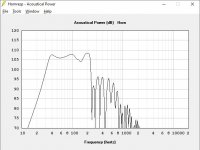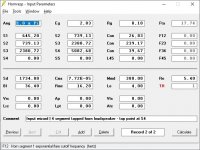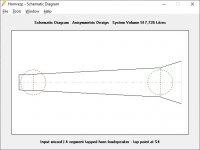Hi all,
I'm busy designing a subwoofer to be used at the scuba diving team "watering hole" clubhouse. It's a fixed installation with 4x JBL EON712's used as tops. I have space to fit 1 sub of about 1x1x0,7m. Normally this is used for background music, but we also have parties about 5-6 / year. Total floor area is about 80m2, total volume is about 240m3.
For now I have a 500W amp and plenty of DSP (DEQ2496) available to drive this.
I was looking at the THAM 18 and just for fun I decided to scale it up by 1.167X and sim it with the Beyma 21QLEX1600fe. Sims look really good to me.
Is this a totally stupid idea / am I missing something. Or could this be the sub to really pressurise the room if we want to?
Any toughts appriciated!
I'm busy designing a subwoofer to be used at the scuba diving team "watering hole" clubhouse. It's a fixed installation with 4x JBL EON712's used as tops. I have space to fit 1 sub of about 1x1x0,7m. Normally this is used for background music, but we also have parties about 5-6 / year. Total floor area is about 80m2, total volume is about 240m3.
For now I have a 500W amp and plenty of DSP (DEQ2496) available to drive this.
I was looking at the THAM 18 and just for fun I decided to scale it up by 1.167X and sim it with the Beyma 21QLEX1600fe. Sims look really good to me.
Is this a totally stupid idea / am I missing something. Or could this be the sub to really pressurise the room if we want to?
Any toughts appriciated!
Attachments
looks good, whats the max SPL? also you may need more bracing than the THAMM18. Hopefully the EON712 is better than the previous version, one of the worst sounding speakers I have ever encountered!
Make sure you're making the most of that driver - check excursion with 500W input. A larger amp might be in order.
Chris
Chris
Max SPL is about 135dB in 1pi space. Could be a little more with more amp power, but power compression surely will kick in.looks good, whats the max SPL? also you may need more bracing than the THAMM18. Hopefully the EON712 is better than the previous version, one of the worst sounding speakers I have ever encountered!
The 712's sound quite good to me. Especially after I added some EQ, taming the top end a bit. They replaced 4 JBL control 5's that where 20+ years old, so the bar was not set very high. Nevertheless happy with them so far. They do a good job.
Yes, basically it's amp power limited with 500W. Could handle double that with a second order high pass filter at about 29Hz. Difference in acoustical output probably won't be 3dB because of power compression.Make sure you're making the most of that driver - check excursion with 500W input. A larger amp might be in order.
Chris
For now this is what's at hand, but maybe I can get a Crown XLS 2502 next year. That should be plenty and measured pretty good at ASR.
Good job,
Building your own loudspeaker is never an stupid idea if you know what you are doing. Besides THAM is a solid design, you might find in the link below more design options that might be easier to build or deliver better result little Tapped Horn SS style once your have more flare to control and to improve the response.
Skram is a BOX designed for 21" from Ricci, it's a compound horn, take this one as an example.
https://freeloudspeakerplan.rf.gd
Building your own loudspeaker is never an stupid idea if you know what you are doing. Besides THAM is a solid design, you might find in the link below more design options that might be easier to build or deliver better result little Tapped Horn SS style once your have more flare to control and to improve the response.
Skram is a BOX designed for 21" from Ricci, it's a compound horn, take this one as an example.
https://freeloudspeakerplan.rf.gd
Didn't know that site yet, will have a look, thanks!Good job,
Building your own loudspeaker is never an stupid idea if you know what you are doing. Besides THAM is a solid design, you might find in the link below more design options that might be easier to build or deliver better result little Tapped Horn SS style once your have more flare to control and to improve the response.
Skram is a BOX designed for 21" from Ricci, it's a compound horn, take this one as an example.
https://freeloudspeakerplan.rf.gd
I do have experience building my own speakers, have 3 pairs at home with increasing "difficulty level" (simple br bookshelf, MTM monitors and my last build, a full range active with horn loaded compression tweeters, sealed mids and transmission line subs).
Not so experienced with these PA style subs, and no experience with tapped horns. Building it will be "outsourced" to a friend with a full woodworking shop. I will help of course but I'm far better with a soldering iron than a wood saw...
Anything specific to be aware of when building these? I guess bracing is very important with these kinds of SPL's.
For home use, you might not need Tapped horn, but if you really want to use this design, the Single Fold one could be a good start, or even a dual fold, you might achieve the same performance as THAM.
if space is not a problem, I'd go paraflex design
if space is not a problem, I'd go paraflex design
There is this option too.
https://www.diyaudio.com/community/...-better-than-tapped-horn.391782/#post-7161928
https://www.diyaudio.com/community/...-better-than-tapped-horn.391782/#post-7161928
Pressure chamber is surely handy for a scuba diving center 😉Or could this be the sub to really pressurise the room if we want to?
SCNR
🤣🤣🤣Pressure chamber is surely handy for a scuba diving center 😉
SCNR
Could use a couple of 12L tanks @ 300 bar for that. That's a lot of air moving...
21" drivers generally offer a little more displacement volume per unit cost than 18" ones, but the choice is extremely limited in comparison. I love them!
Power-wise, no less than 2kW per driver.
Power-wise, no less than 2kW per driver.
It's not for home use, but the space is not huge at about 80m2 / 240m3. Space for the sub is limited to 1x1x0.7m so anything that will fold into that 700L could be an option. Would really like something that can give that "thumping base" base feeling when playing EDM. That's a favorite music style of quite a few of the younger members of the scuba diving team, the ones that also stay late after training and crank up the music.For home use, you might not need Tapped horn, but if you really want to use this design, the Single Fold one could be a good start, or even a dual fold, you might achieve the same performance as THAM.
if space is not a problem, I'd go paraflex design
21" drivers generally offer a little more displacement volume per unit cost than 18" ones, but the choice is extremely limited in comparison. I love them!
Power-wise, no less than 2kW per driver.
I'll take that into account. Just curious, where does that 2kW figure come from? Headroom for the amp to prevent clipping? The driver goes way beyond xmax with that kind of power delivered.
It's not for home use, but the space is not huge at about 80m2 / 240m3. Space for the sub is limited to 1x1x0.7m so anything that will fold into that 700L could be an option. Would really like something that can give that "thumping base" base feeling when playing EDM. That's a favorite music style of quite a few of the younger members of the scuba diving team, the ones that also stay late after training and crank up the music.
As you might saw in the other thread Manifold-MTH vs TH, they give you more SPL around 100Hz as Paraflex do, they are "easy" to build and you have different styles to choose. There is the Roar too but I think it has narrow bandwidth compared to Paraflex. Manifold-MTH in the other side might give you little more bandwidth, so it may depend with what loudspeaker you will crossover and at what frequency.
If you can achieve the same lower frequency amplitude but at the same time you can get more SPL close to 100Hz, it improves the kick feeling due to chest resonance.
I'll take a good look tomorrow / fire up HR. Looks like an interesting concept. I did look at the ROAR series but the bandwidth is a bit to limited for my taste. I would like the sub to cover from about 40Hz and cross over LR24 @ 100Hz.As you might saw in the other thread Manifold-MTH vs TH, they give you more SPL around 100Hz as Paraflex do, they are "easy" to build and you have different styles to choose. There is the Roar too but I think it has narrow bandwidth compared to Paraflex. Manifold-MTH in the other side might give you little more bandwidth, so it may depend with what loudspeaker you will crossover and at what frequency.
If you can achieve the same lower frequency amplitude but at the same time you can get more SPL close to 100Hz, it improves the kick feeling due to chest resonance.
Yes, basically it's amp power limited with 500W. Could handle double that with a second order high pass filter at about 29Hz. Difference in acoustical output probably won't be 3dB because of power compression.
For now this is what's at hand, but maybe I can get a Crown XLS 2502 next year. That should be plenty and measured pretty good at ASR.
Standard processing would be a 4th order filter a few Hz below the bottom tuning frequency.
FWIW, the ASR reviews focus strongly on performance pertinent to HiFi, but perhaps less so for PA duties. For instance, I skimmed a few reviews and didn't see any mention of crest factors - I suspect it's just sine wave testing. Nor did I see any mention of current draw or power factor.
Given that music rarely has a 3dB peak-to-average ratio, the short-term peak output available from modern PA amplifiers isn't being measured properly.
Chris
4th order is also an option of course. No real preference, just protection against over excursion. Group delay will be higher, not sure if it will be audible.Standard processing would be a 4th order filter a few Hz below the bottom tuning frequency.
FWIW, the ASR reviews focus strongly on performance pertinent to HiFi, but perhaps less so for PA duties. For instance, I skimmed a few reviews and didn't see any mention of crest factors - I suspect it's just sine wave testing. Nor did I see any mention of current draw or power factor.
Given that music rarely has a 3dB peak-to-average ratio, the short-term peak output available from modern PA amplifiers isn't being measured properly.
Chris
ASR is definitely focused on HiFi en indeed I believe they use sinewave testing. Still some useful info there.
4th order is standard as it protects against over excursion for ported designs, the extra group delay isn't audiable. Its normal for PA sub design (maximum output) to tune so that at the maximum power input the driver is hitting ~xmax+10/20%.
If you have the budget the way to maximise the output in the space you have* would be a multi driver sub: https://www.danleysoundlabs.com/wp-content/uploads/2022/02/TH-412-spec-sheet1.pdf this works out at 880L volume wheras you have 490L. I would guess a dual 15" design or dual 18" would give you the most output at 40Hz (for EDM).
*I'm also assuming you can use a more powerful amplifier.
*I'm also assuming you can use a more powerful amplifier.
- Home
- Loudspeakers
- Subwoofers
- THAM 21, stupid idea?


